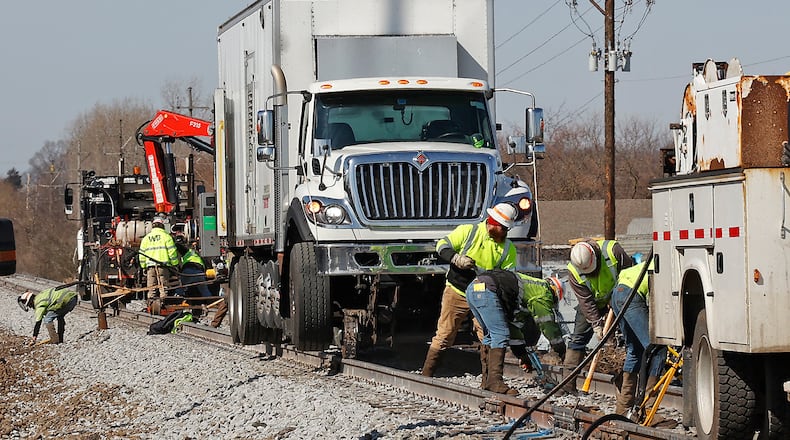U.S. Sen. Sherrod Brown on Thursday said only luck prevented Springfield from a disaster similar to one like happened in East Palestine, Ohio, nearly a month ago.
According to the train’s manifest, which the newspaper obtained in a public records’ request, 31 cars were labeled as carrying hazardous substances on March 4.
Three of those cars were carrying residual amounts of the hazardous substances, according to the manifest.
Mark McClain, a Cedarville University chemistry professor who also serves as the chair of the college’s department of science and mathematics, walked through the manifest with a News-Sun reporter.
The three cars carrying residual amounts of hazardous materials once contained two different kinds of acids and pentanes. Pentanes are used to make packing pellets, construction adhesive and more. Pentanes can also be used as a fuel additive, McClain said.
Another four cars were carrying benzene, which McClain said is a chemical that contributes to a “significant portion of modern life.” It’s used to make different kinds of Nylon for clothing and containers, laundry detergent and dishwashing products, pesticides and plastics.
Potential for fire
Benzene is a known carcinogen in its raw form, with the risk typically being through inhalation.
Nine cars carried liquid petroleum gas, used in cooking and heating.
Both that substance and benzene are flammable. It’s difficult to say, though, what Springfield’s derailment would have looked like if cars containing either substance were involved in the incident.
“This flammability all depends on there being an ignition source… under the right conditions, there could be a fire,” he said. “What harm it would have to the environment would depend critically on certain things. Is there a fire, or is it just things evaporating? Is it running into bodies of water, drains that go into waterways? Those kinds of things.”
Four cars were carrying hydrochloric and sulfuric acid. Sulfuric acid is used in car batteries, and hydrochloric acid is also used in metal production. Both are also commonly used to make fertilizer.
McClain said the two acids are corrosive and reactive.
“If they spilled out on the ground, over parts of the train, they could begin to react with materials in the environment, metals in the area,” he said. “This could produce harmful or explosive gasses due to the reactivity of strong acids.”
McClain said it’s difficult to be certain from the manifest what was inside several cars labeled as carrying “liquid hydrocarbons.”
“It could be anything from crude oil to a mixture of small molecules,” he said. “But, what I would take from its presence in a tank car is that it’s useful to somebody or something for chemical synthesis.”
Dozen cars with alcohols
Twelve cars on the train were also simply labeled “alcohols” and could have contained ethanol, given the companies listed as the shippers for the cars being agriculture-based companies in Ohio.
McClain said more than 600 million gallons of ethanol are made in the state each year.
“To transport 600 million gallons… that would fill approximately 20,000 rail cars. And we just saw 12 of them,” he said.
McClain said if ethanol were transported on tanker trucks on the highway instead, 100,000 would need to be on the roads for shipping.
“If we’re going to make this a part of our economy, you have to transport it,” he said. “So we need to make sure we can do it the safest way we can.”
More than 99.9% of rail hazmat shipments reach their destination without a release caused by a train accident, according to the American Association of Railways.
Not a high hazardous train
The train’s contents did not meet the federal definition of a high hazardous flammable train, which requires additional advance notification to the state if a train has 20 cars together or 35 rail cars total carrying Class III highly flammable materials, like crude oil, gasoline and ethanol.
“It was a mixed freight train and not a HHFT,” said Warren Flatau, deputy director of public affairs for the U.S. Department of Transportation-Federal Railroad Administration. “FRA is conducting an investigation which is open and ongoing.”
The National Transportation and Safety Board also confirmed it will be investigating the Springfield derailment. Investigators were on scene earlier this week.
The federal safety agency is expected to release a preliminary report about the derailment in the coming weeks.
Sen. Brown, D-Ohio, on Thursday called for action to hold Norfolk Southern accountable for its train accidents in Ohio and called attention to the Springfield derailment last weekend.
“On Saturday evening, just a month after the company’s disaster in East Palestine, another Norfolk Southern train derailed in Springfield, Ohio,” Brown said at a Senate hearing in response to Norfolk Southern problems.
“The only thing that saved Ohioans from another disaster was luck,” he said. “We need a little more than that.”
He and Sen. JD Vance, R-Ohio, have proposed bipartisan legislation they say will improve railroad safety and accountability.
McClain said he’s thankful the Springfield derailment did not include a HAZMAT situation.
He said he encourages people who may be anxious about exposure to chemicals to carefully read labels on products they purchase.
“That will kind of help inform them of the dangers there are in their own home, much less a railroad derailment in their neighborhood,” he said. “We use chemicals in lots of ways, and they need to be used carefully, safely.”
About the Author

